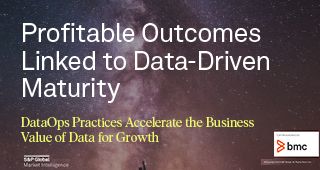In 2022, 5.7 million people attended Formula One races around the world, with revenue growing to $2.573 billion. Those two nuggets of intel about one of the biggest sports in the world are data points, and in our latest BMC Transformational Speaker Series, BMC VP of Sales Jeff Hardy and Oracle Senior Director of ISV Success Directors Dan Grant welcomed Formula One Racing Data Analyst Mark Gallagher for a wide-ranging discussion on how data, analytics, and insights are being used to improve efficiency, safety, and more for the organization’s drivers and vehicles. Here are a few excerpts from the conversation.
Mark shared that the organization’s technology evolution since 1950 has been iterative. “We started off by learning how to make cars go faster. We then embraced aerodynamics and learned how to make aircraft go faster, which is effectively what a Formula One car is today. It’s an inverted jet fighter,” he says. “And really the third suite of tools have been digital. And it’s extraordinary to really reflect on the fact that Formula One’s digital transformation has been taking place for more than half of its history.”
“Now to this day, all teams and particularly the more competitive teams [are] utilizing data and analytics. Formula One’s all about action. And we want insights. We want to go on a journey of knowledge rather than a journey of hope. We don’t want to hope we win. We want to know we’re going to win. And that’s where the actionable insights come from.”
While initial analytics revealed what was going right, Mark says he and his team wanted more, and better, data and insights. “We suddenly started wanting a deeper dive. What’s going to help us go faster? What’s going to help us manage risks better? What’s going to enable us to prevent negative outcomes and drive positive outcomes,” he explains. “And that there is the analytics space. Race car drivers haven’t changed very much over the years, but the ecosystem within which they’re operating is night and day difference, thanks to our data-driven environment.”
Mark acknowledged Formula One has had its share of negative outcomes over its history, with fatal accidents occurring on the track every year or multiple accidents per year several years ago, and says the advances they have made through technology mean that younger drivers have never experienced that. “One of the really big changes over the last quarter of a century has been the improvement in our risk management, our ability to use real-time data to spot trends, to analyze failure modes developing, to look at diagnostics in real time and say, ‘Actually, there’s a problem developing,’” he points out.
“When you look at a lot of accidents, they’re caused by a failure, component failure that’s caused by a particular issue arising. In many cases … back in the day, we couldn’t do anything about [that]. But now we can. We can instantaneously, if necessary, call a halt to operations. That doesn’t happen very often, but if we need to, we can call the whole operation.”
“We can manage the lifecycle of up to 80,000 components that we’re going through on the car through the year. And that means that every single aspect and in total, granular detail is being managed so effectively to ensure that we get optimized performance and that risks are minimized. So, when people ask what’s been the big change for me, there is an enormous change.”
Mark adds that airlines have done the same thing. “We’re not the first industry to do that. Every time we get in an aircraft, we’re getting on board something that is inherently safe because of the culture of examining data, forensically examining data from past events in order to ensure that future outcomes are possible,” he explains. “So again, Formula One has looked at aviation and aerospace and said, ‘That’s the level of engineering we’re going to move to.’ And data-driven tools have been integral to that evolution.”
Mark says that between 1950 and 2000, about 45 percent of the time, Formula One cars simply failed due to mechanical issues, and that’s also now become a thing of the past. “Considering that we pride ourselves as engineering companies, we actually weren’t very good at building robust, reliable technology. Today, Formula One world champions can realistically expect to go through a whole season without suffering a single mechanical or technical failure,” he shares.
“I think Lewis Hamilton … went four and a half years without a single significant technical failure. I’ve never had a road car that’s lasted four and a half years with robust technology. So, in Formula One, that quality, that reliability, the foundation stones of the quality of our engineering and outcomes, that has been made possible by our data-driven environment. We’re no longer hoping everything’s going to be okay. We know what the outcome can be.”
If you’re a fan of movies about race cars, you’re familiar with the big moments where a trainer or a coach clicks the stopwatch to marvel at how fast the car got around the track. Mark says they’re light years beyond that. “When we look at the metrics that we are interested in, it all started with the humble stopwatch, [and us wondering], ‘How can we get from A to B faster than our competitors?’” he says.
“How do we get from where we are now to where we want to be more efficiently than our competition? [Now], we are looking at thousands of parameters. We’re talking about 300 sensors on the car, maybe … 1,200 channels of data. The cars are generating … about ten gigabytes of data per lap and a couple of terabytes of data over the weekend from the car. And in terms of the KPIs …we’ve got a ton of people looking at all the metrics. We know the pressures of the tires, we know the temperatures of the tires, we know everything that the human being driving the car is doing.”
“Most of what you’re looking at is all doing fine, but we are really interested in the opportunities, and this is where the actionable insight’s kick in, because [when] you get an anomaly … it’s amazing what we can do. And in its most extreme form, let’s say you were leading the race and you had three laps of the race remaining, and an issue develops on a particular system, we can monitor that system. We can talk to the driver and say, ‘Can you modify your driving because this system is beginning to fail,’ or ‘There’s an issue with this system.’ We might even tell the driver to switch off a particular system. We’ve even had occasions where we’ve had Formula One drivers do the equivalent of control, alt, delete on their steering wheel and literally reset everything and it’s cured a problem.”
“In terms of the metrics that we’re interested in, it’s anything that’s going to show us our benchmark performance against the competition and where the opportunities and the anomalies … and the risks are that we can really dig into some detail that’s going to help us to improve performance.”
“This is why when you see Formula One race car drivers being interviewed after a qualifying session or after a race, they very often say, ‘We’ve got to look at the data.’ And what they’re actually saying is, ‘We’ve got to look at where that issue lies [or] where that opportunity lies.’ It’ll always be the thing or the items which are going to lead to us getting a performance improvement. So, our data-driven environment from the driver’s perspective, is all about managing and gaining insights into any metrics that are going to supercharge our continuous improvement as a race team.”
BMC is keenly interested in the world of data and analytics, and helping companies pursue and improve their data strategies. We recently commissioned 451 Research, part of S&P Global Market Intelligence, to survey 1,100 IT and data professionals from diverse global regions, and those finding have just been released in a new report, Profitable Outcomes Linked to Data-Driven Maturity. You can also check out our deep dive into the world of DataOps here.
To learn more about how the need for speed and the need for data is driving the future of Formula One, Mark’s thoughts on artificial intelligence and autonomous vehicles, and how one driver was so thirsty for data he was checking the screens around the track while driving 200 MPH during a race.







